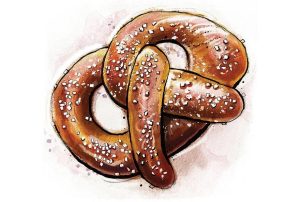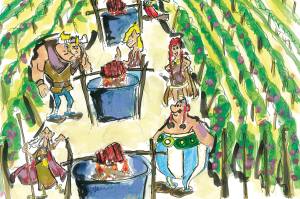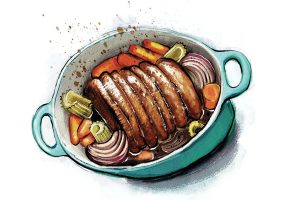A Partridge in a Pear Tree
Partridge pear terrine with lingonberries and cognac, served on Scandinavian bark bread.
Two Turtle Doves
A miniature coeur à la crème on a large white plate, surrounded by two doves sketched in raspberry coulis.
Three French Hens
Hot chicken consommé.
Four Calling Birds
The best-known calling bird (or songbird) is the lark, traditionally roasted and devoured bones and all. But many today prefer their larks ascending, so instead this course features Japanese quail, originally domesticated for its vocal talents and only subsequently introduced into cuisine. Sliced poached quail breast is served on a bed of arugula and endive with pomegranate, walnuts and orange vinaigrette.
Five Golden Rings
A single ball of Champagne sorbet, garnished with flakes of edible gold leaf and five rings of candied lemon peel.
Six Geese a-Laying
The pièce de résistance. Roast goose with honey, apples and Calvados. In lieu of freshly laid eggs, serve potatoes cooked in goose fat, nestled in a profusion of French beans.
Seven Swans a-Swimming
Choux pastry swans swimming across a mirror, filled with chilled pineapple mousse as a palate cleanser. Their wings are formed by splitting the top half of the pastry into two gracefully curved appendages; a dusting of icing sugar adds a snowy touch.
Eight Maids a-Milking
Usually an odd number of cheeses is de rigueur, but on this occasion, we must serve exactly eight, ranging from milky mildness to Stiltonian bombast. In honor of the animals gathered at the creche, as many varieties of milk-giving animals as possible ought to be represented: cows but also sheep, goats and buffalo. Camel cheese does exist and would fittingly recall the beasts on which the Three Kings traveled to Bethlehem.
Nine Ladies Dancing
Legend has it that pavlova was invented to commemorate famous Russian ballerina Anna Pavlova’s tour through the land down under; its glossy meringue base echoes the frothy yet crisp effect of the classical tutu. Usually topped with fresh fruit, the nine mini-pavlovas that make up this course are heaped high with lightly sugared plums in homage to Tchaikovsky’s Christmas classic.
Ten Lords a-Leaping
Drambuie was the first liqueur allowed in the cellars of Britain’s House of Lords, and it’s easy to imagine the innovation causing the peers of the realm to leap with glee. Based on a recipe that belonged to Bonnie Prince Charlie, Drambuie’s aristocratic antecedents are unimpeachable. Served with coffee.
Eleven Pipers Piping
Since it’s Christmas, a second liqueur is appropriate. Perique Liqueur de Tabac is made from fermented Louisiana perique tobacco, a variety that brings out pipe smokers’ inner truffle hound. It’s been compared to a fine dry cognac, with notes of tobacco and leather.
Twelve Drummers Drumming
The timpani build a crescendo as the feast nears its final cadence. Enter the mignardise, inspired by pastry chef Amaury Guichon: miniature Black Forest cakes modeled to look like tiny drums. Thin circles of chocolate sponge cake are set in a frame of molded chocolate rods; a layer of whipped cream and mascarpone surrounds the kirsch-drenched cherry heart.
This article was originally published in The Spectator’s December 2020 US edition.


















